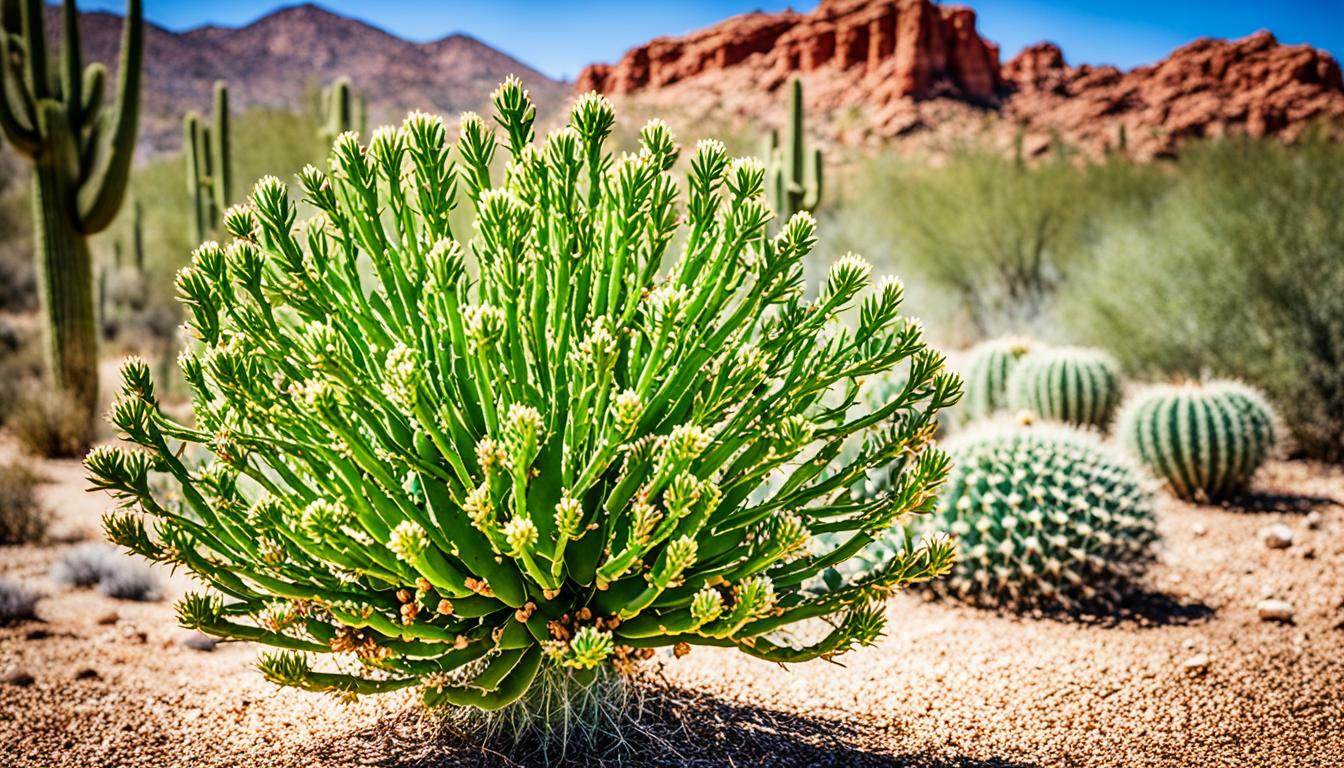Did you know the Mistletoe Cactus is also called Rhipsalis baccifera? It’s not a real cactus, even though its name says so. This plant is part of the Cactus family. It has hanging stems and green leaves. Many people like it for their homes.
This guide will show you how to take care of a Mistletoe Cactus in your apartment. You will learn about its benefits, like cleaning the air and being safe for pets. You will also find out the right size and how to make it grow. This plant will make your home look great.
Key Takeaways:
- Discover why the mistletoe cactus is a popular choice for apartment dwellers.
- Learn about its air-purifying properties and pet-friendly nature.
- Understand the size and growth requirements of the mistletoe cactus.
- Explore how to grow, care for, and propagate a mistletoe cactus indoors.
- Get expert tips on maintaining the mistletoe cactus, dealing with pests and diseases, and overwintering the plant.
Why Do We Love the Mistletoe Cactus For Apartments?
The mistletoe cactus is great for your apartment. It looks beautiful and is very useful.
Is the Mistletoe Cactus Air-Purifying?
This plant cleans the air. It takes in carbon dioxide and gives out oxygen.
This makes your apartment air fresh and healthy.
Is the Mistletoe Cactus Pet Friendly?
Got pets? The mistletoe cactus is safe for them. It’s non-toxic to cats and dogs.
Your pets can be around this plant with no worries.
How Big Does the Mistletoe Cactus Get?
The mistletoe cactus is small. It grows between 6 to 12 inches tall.
Its stems hang down in a pretty way. This makes it great for small places.
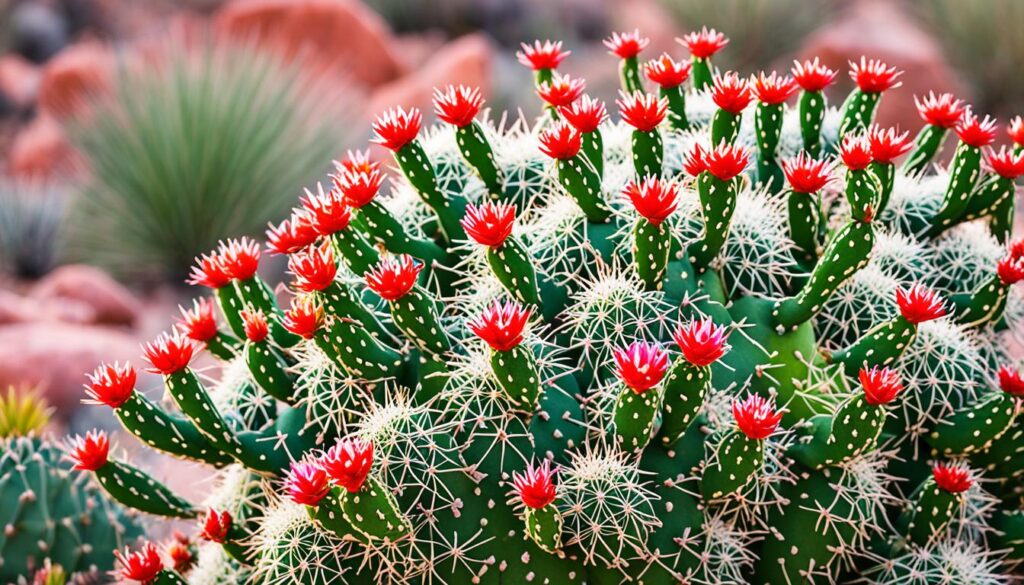
This cactus cleans the air, is safe for pets, and doesn’t need much space. It’s great for both plant lovers and beginners. It makes your home more lovely.
How to Grow a Mistletoe Cactus – Learn to Grow this Indoor Beauty
Growing mistletoe cactus indoors is fun and rewarding. With care, these plants make your home beautiful. Here, we will show you how to grow and care for a mistletoe cactus.
Choosing the Right Pot and Soil
Choose a pot with holes to avoid soggy roots. Use a well-draining mix meant for cacti. It should be sandy and gritty.
Providing Adequate Light
Mistletoe cacti love bright, indirect light. Keep it near a window but out of direct sun.
Watering and Humidity
Water your plant well but let the soil dry before watering again. Don’t overwater. Mistletoe cacti like it a bit dry.
Nutrition and Fertilization
Use a balanced cactus fertilizer in spring and summer. Follow the pack’s directions. Stop feeding in winter.
Pruning and Maintenance
Pruning is not usually needed. But you can trim too long stems. Remove any dying foliage to keep it looking good.
Propagation
You can grow a new plant from a stem cutting. Let the cutting dry for a few days. Then plant it in a well-draining mix. Care for it like a full-grown plant. Soon, it will grow roots.
Monitoring for Pests and Diseases
Check for pests like mealybugs. Treat them quickly if found. Watch for root rot too. Change how you water if you need to.
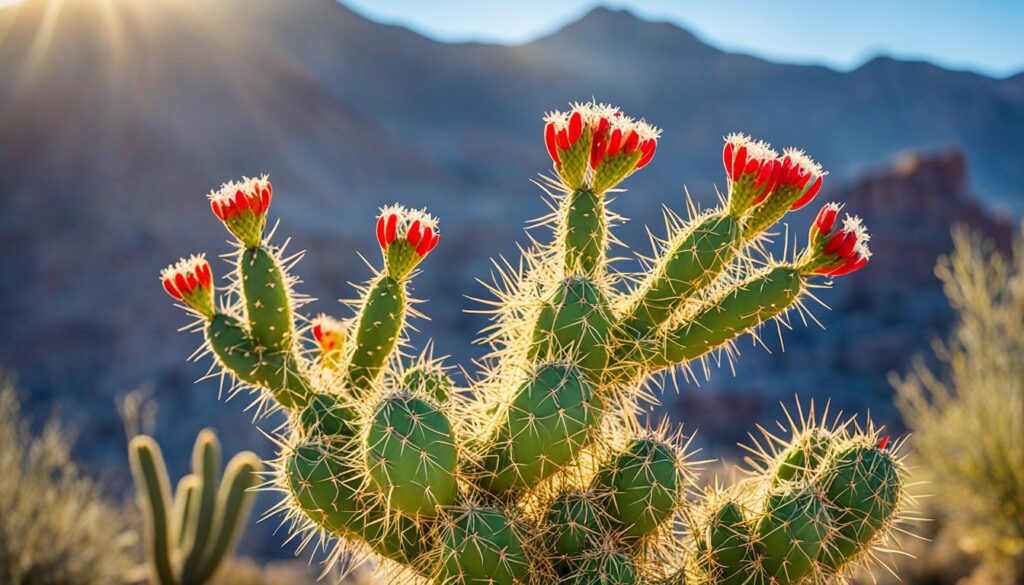
Appearance of Mistletoe Cactus
The mistletoe cactus is special because it looks nice indoors. It has long stems that hang down. They are covered with soft leaves. This makes it look pretty.
It also grows beautiful flowers. The flowers come in many colors like white, pink, and orange. They make the cactus more lovely.
There are small, round berries on it too. These berries can be red, white, or green. They make the cactus fun to look at.
This cactus has long stems, bright flowers, and cute berries. It makes indoors look more beautiful. It’s like having a piece of nature inside.
Light Requirements for Mistletoe Cactus
Your mistletoe cactus needs the right light to grow well. It likes bright, indirect light. This is like the light in the forest where it comes from. Direct sunlight is bad. It can hurt the leaves.
Put your cactus where it gets bright, but not direct, light. Near a north or east-facing window is good. This gives it gentle light. If you can’t do that, use a fluorescent grow light. Put it 6 inches above the plant.
Too little light makes the plant grow poorly. Its stems get too long. Too much light makes the leaves turn yellow or brown. The right amount of light helps your cactus look its best.
Watering Requirements of the Mistletoe Cactus
It’s very important to water your mistletoe cactus correctly. It likes dry places and needs the right amount of water.
The mistletoe cactus doesn’t need water like other plants do. Too much water is bad. Water it well when the top inch of soil is dry. This is usually every 2-3 weeks.
This plant is okay if it doesn’t get watered enough. But, too much water causes problems. Make sure all extra water drains from the pot.
Signs of Overwatering vs. Underwatering
Know the signs of too much or too little water to keep your cactus healthy.
Signs of overwatering:
- Yellowing or wilting of stems
- Soft or mushy roots
- Musty odor coming from the soil
- Fungal growth on the soil surface
Signs of underwatering:
- Shriveled or wrinkled stems
- Drooping or wilting
- Dry, brittle roots
- Soil pulling away from the sides of the pot
If you see these signs, change how you water your cactus. Learning the cactus’s water needs takes time.
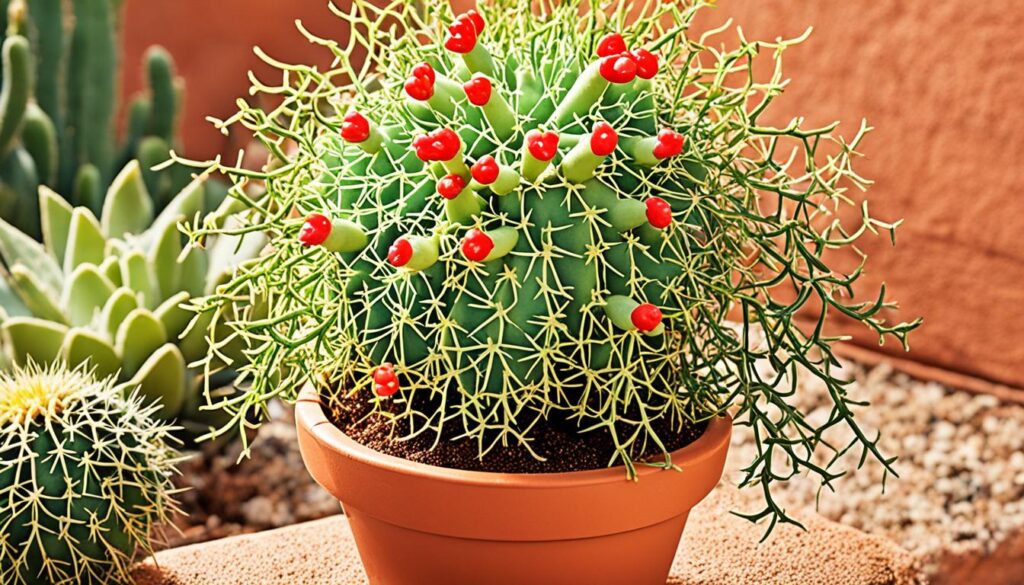
Table: Watering Checklist for the Mistletoe Cactus
| Watering Strategy | Frequency | Indication of Proper Watering |
|---|---|---|
| Thoroughly soak the soil | Every 2-3 weeks (or when the top inch of soil is dry) | The excess water drains out of the pot |
| Allow the soil to dry between waterings | Avoid frequent or constant watering | No signs of overwatering or underwatering |
Use this checklist to water your cactus right. It’s better to water it too little than too much. The cactus can handle dryness well.
Fertilizing a Mistletoe Cactus
Fertilizing is key for your mistletoe cactus to grow well. Fertilizers give necessary food that the plant might not get naturally. I’ll show you how to feed your mistletoe cactus right.
Recommended Fertilizer for a Mistletoe Cactus
Choose a balanced fertilizer made for cacti and succulents. Get one with low nitrogen but more phosphorus and potassium. Such fertilizers help the roots, flowers, and health of the plant.
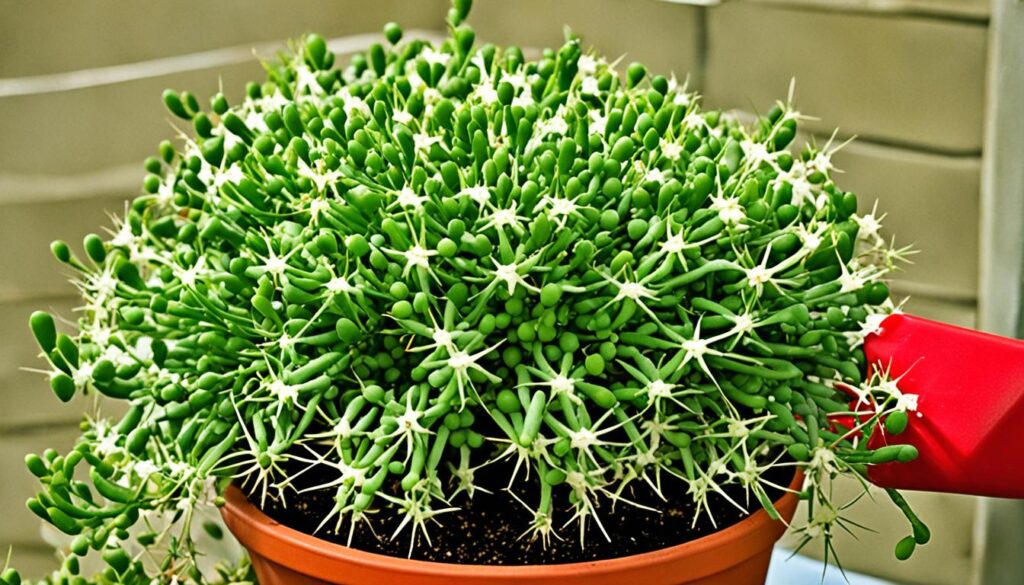
Here are good fertilizers for mistletoe cacti:
| Fertilizer | N-P-K Ratio |
|---|---|
| Cactus Juice Organic Plant Food | 2-7-7 |
| Dr. Earth Exotic Blend Cactus & Succulent Fertilizer | 4-6-7 |
| Miracle-Gro Indoor Plant Food | 1-1-1 |
| Schultz Cactus Plus Liquid Plant Food | 2-7-7 |
Always check the package for how much and how often to use. Too much fertilizer can hurt your cactus. Use the right amount, as the directions say.
Now you know why and how to fertilize your mistletoe cactus. And you have some fertilizers to try. This will help your plant get what it needs to do well.
Potting a Mistletoe Cactus
Getting the potting right is key for your mistletoe cactus to be healthy and grow. Make sure you pick the right pot size, use the right soil, and repot when needed.
Choosing the Right Pot Size
Picking the right pot size is important. It should be a bit bigger than the plant’s roots but not too big. This helps the soil dry properly and keeps the plant stable.
It’s better to choose a pot that’s a little small than one that’s too big. A too-big pot can make the soil too wet, which is bad for the roots.
Using the Right Potting Mix for a Mistletoe Cactus
The soil for your cactus needs to drain well. Use a mix made for cacti and succulents. It has things like perlite, sand, and peat moss in it.
Don’t use regular potting soil; it’s too wet for cacti. Also, avoid soil that’s too heavy or doesn’t drain well.
Repotting When Necessary
If your cactus gets too big, you might need to put it in a bigger pot. You’ll know it’s time if roots show at the bottom, it stops growing, or it tips over easily.
When moving your cactus to a new pot, be gentle. Check the roots. If they’re too tight, it needs a new home. Use new soil and follow the pot size tip from before.
Be careful with the cactus when you repot it. Its stems can break. It’s also a chance to check for any root problems.
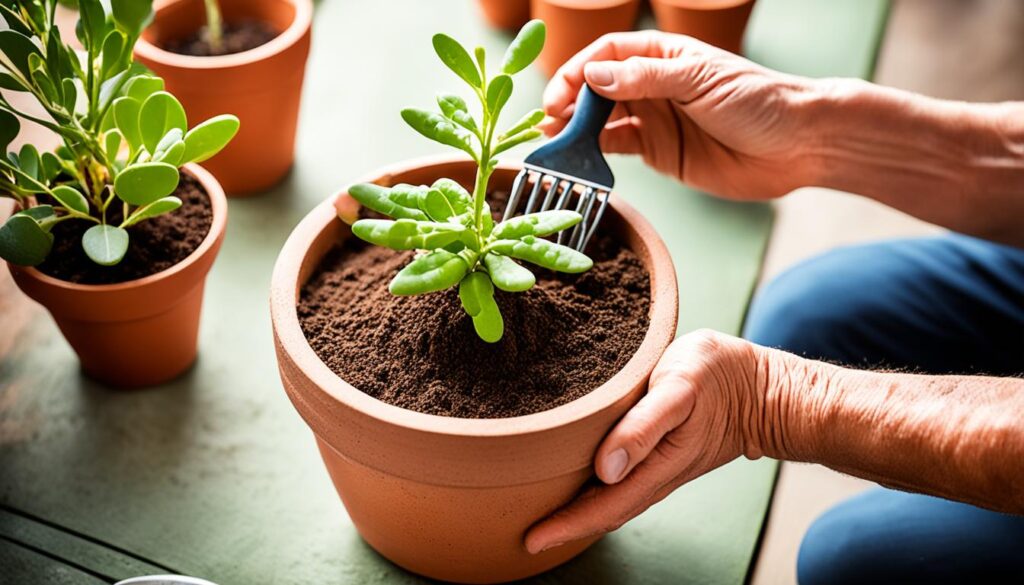
Propagating a Mistletoe Cactus
You can propagate a mistletoe cactus in many ways, like stem cuttings, division, and seeds. Each way has good and bad points. You can pick what works best for you. Let’s see what you can do:
Stem Cuttings or Seeds?
Using stem cuttings to grow mistletoe cacti is easy and common. Just cut a healthy stem and let it dry for a few days. Then, plant it in soil that drains well. Keep the soil a bit moist. Soon, you should see roots.
But, growing them from seeds can be harder. You need to get ripe seeds from the plant. Plant these seeds in good soil. Then, keep them in a place that’s warm and moist. With care and time, seeds will sprout and become new plants.
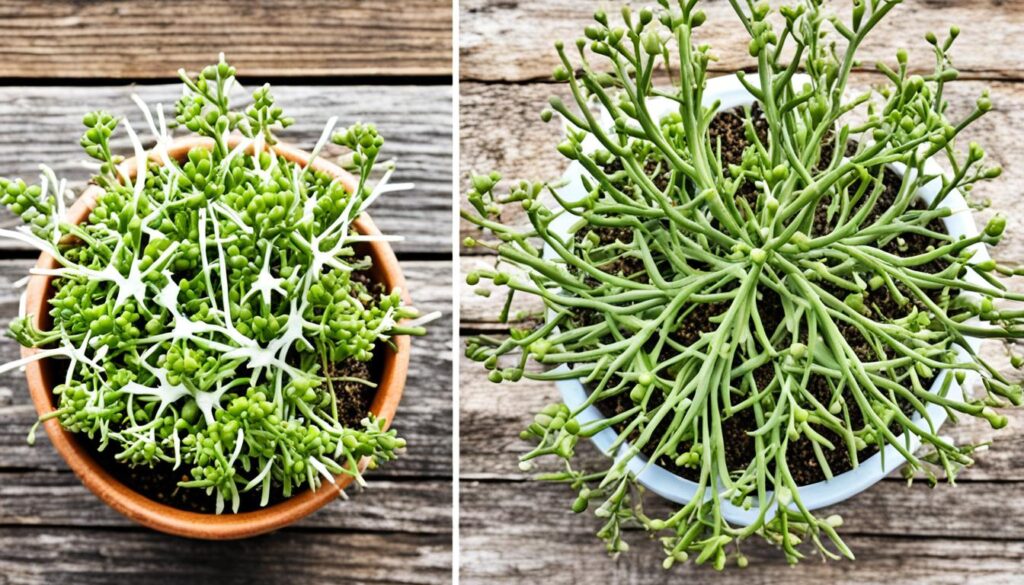
Division of a Mistletoe Cactus
Another way to make more mistletoe cacti is by division. This means you split a grown plant into smaller ones. Each will have its own roots. Take the plant out of its pot and carefully split it into pieces. Make sure each piece has roots. Then, plant them in new pots with soil that drains well.
This method is good for making your plant collection bigger. It also helps older plants grow better. But, it’s important to make sure every piece has enough roots to grow well.
| Propagation Method | Advantages | Disadvantages |
|---|---|---|
| Stem Cuttings | – Easy and reliable method – Allows for cloning exact genetic replicas of the parent plant – Faster results compared to seeds | – Requires a healthy parent plant – Stem cuttings may take longer to establish roots |
| Seeds | – Offers the opportunity for genetic variation – Can be a rewarding and exciting horticultural experience | – Longer germination and growth period – Requires more patience and careful seed handling |
| Division | – Provides an immediate increase in the number of plants – Helps rejuvenate older or leggy plants | – May cause some root disturbance and shock – Not all mistletoe cactus species or varieties divide easily |
Choose any method to grow more mistletoe cacti. Remember to give them the right care. They need good light, enough water, and the right amount of humidity. With the right care, you can grow your collection of these interesting plants.
Growth and Development of the Mistletoe Cactus
The mistletoe cactus has a special way of growing. It’s important to know this for good care.
Its long stems can grow quite big. This makes it great for keeping inside.
It gets pretty flowers and berries as it grows. People really like it because of this.
Here are some tips for taking good care of your cactus:
Light: It loves bright but not direct sunlight. Keep it by a window that’s not too sunny.
Temperature: It likes it not too hot, not too cold. Keep it between 60°F and 75°F.
Watering: Don’t water it too much. Let the soil dry a bit before watering again.
Humidity: It likes some moisture in the air. A humidifier can help in dry places.
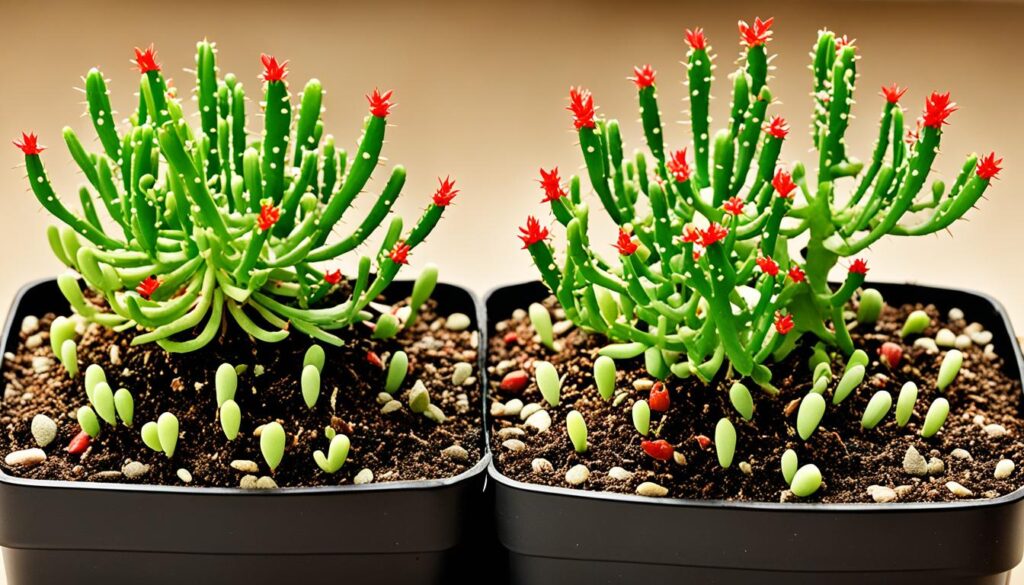
Learn about mistletoe cactus growth. Give it what it needs. Then, it will look beautiful in your home.
Dealing with Pests and Diseases in the Mistletoe Cactus
The mistletoe cactus is a stunning plant that lights up any room. But, like all plants, it can get sick or have bug problems. It’s important to keep an eye out and take action early to keep your cactus healthy.
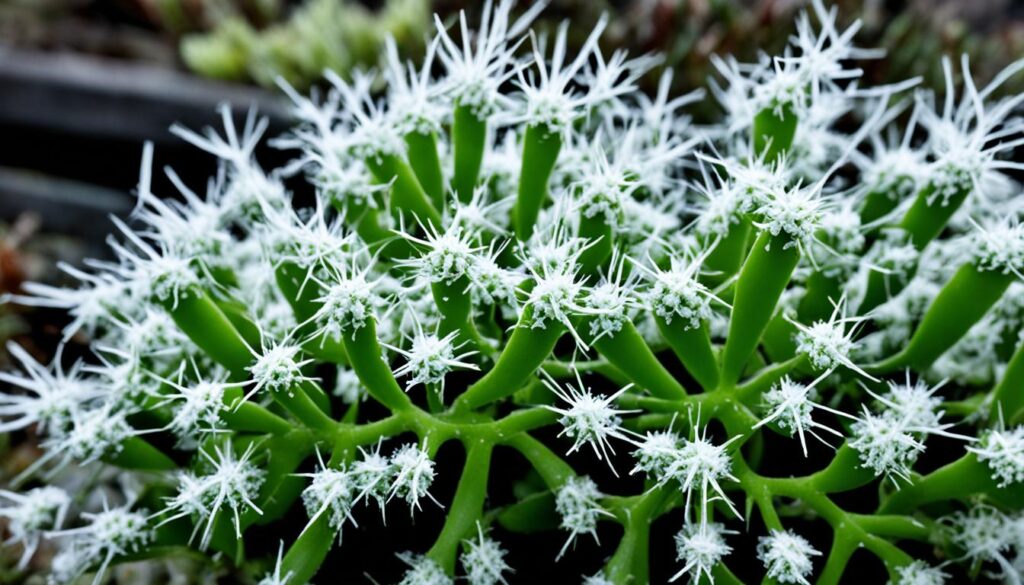
Checking your cactus often helps stop bugs from moving in. Watch out for mealybugs, scale insects, and spider mites. These bugs suck the plant’s juice and hurt the leaves. This causes slow growth and harm to the cactus.
To get rid of bugs, try wiping them off with a wet cloth. If there are a lot of bugs, you might need insect soap or oil. Be sure to use these products right by reading the label.
Mistletoe cacti can also get sick from too much water or bad drainage. This can cause root rot or fungal diseases. Make sure your cactus has good soil and don’t water it too much.
Keeping your cactus healthy is all about prevention. Here are some tips:
- Give your cactus the perfect amount of light, water, and air moisture.
- Look closely at your plant for any signs of trouble, like yellow leaves or sticky spots.
- If a plant gets sick, keep it away from your other plants to stop the spread.
- Check how wet the soil is and try not to overwater.
- Good air flow helps keep away fungus.
- Clean your cactus’s leaves to keep bugs away.
By doing these things and keeping an eye out, you can have a healthy and happy mistletoe cactus in your space.
Common Mistletoe Cactus Pests
The mistletoe cactus is strong but can still get pests. Knowing these pests and acting fast keeps your cactus healthy.
Two common pests are mealybugs and scale insects. Mealybugs look powdery white and harm the plant. Scale insects seem like tiny bumps and also hurt the plant.
Check your cactus often for pests. White clusters or bumps mean there’s a problem. Other pests like spider mites and aphids can also harm your cactus.
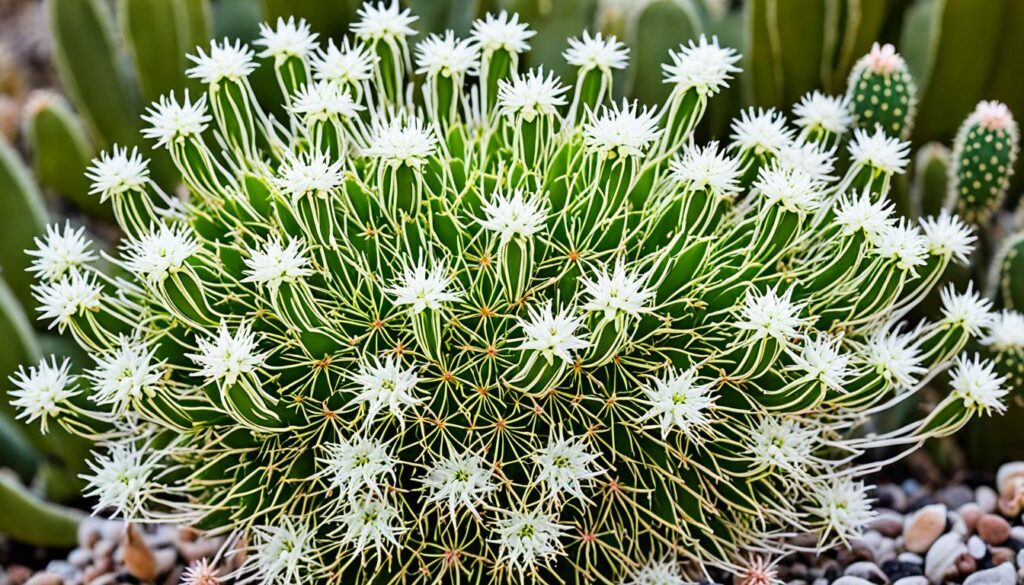
Dealing with Pests in the Mistletoe Cactus
To fight pests, start early. Use these ways to keep your cactus safe:
- Manual Removal: For a few pests, use a damp cloth to wipe them away. Clean the plant well to stop more pests.
- Natural Remedies: Try natural sprays like neem oil mixed with water. Or use soap water as a safe bug spray.
- Chemical Treatments: If there are lots of pests, you might need chemicals. Be careful to follow the instructions and protect everything around.
Stopping pests before they start is best. Check your cactus a lot, take good care of it, and make sure it has what it needs.
Natural Predators
Using nature’s helpers like ladybugs and lacewings works well against pests on mistletoe cacti. These helpers eat pests that harm your plants, keeping them healthy.
They go after aphids, mealybugs, and other bad bugs. Adding them to your garden or home sets up a natural defense. This keeps your cacti safe from pests.
Isolate Infected Plants
If you see a sick mistletoe cactus, keep it away from the healthy ones. This stops the pests or disease from spreading to other plants.
Put the sick plant in a separate spot. Do this until you can fix the problem. It keeps the other plants safe.
Chemical Treatment
Sometimes, you might need chemicals to fight bad pest outbreaks. But, use these only when you really have to. They can hurt good bugs and the environment.
Always read and follow the label when using chemicals. Be careful to keep yourself, pets, and nature safe.
Disease Prevention For Mistletoe Cacti
Keeping mistletoe cacti healthy is key. Follow some simple steps to cut disease risks and make your plants last longer.
Good plant care is very important. This means right watering and care. It also means making the perfect home for your cacti. Too much or too little water can cause problems.
Check your plants often for signs of sickness. Look for changes in color, mold, or weird spots.
Clean your tools to stop germs from spreading. Clean your tools before and after you trim or grow more cacti.
Don’t let your plants get too crowded. Space them out so air can flow well. This helps keep away mold and bacteria. Also, keep your growing area clean and clear of old plant bits.
Quarantine new plants before adding them to your collection. This lets you watch them for diseases without risking your other plants.
Use these tips to keep your mistletoe cacti healthy and happy.
Tips for Maintaining Mistletoe Cacti
Keeping mistletoe cacti healthy is important. Here’s how to make sure they are doing well:
Wiping Leaves
It’s key to wipe the leaves regularly. This keeps them clean and healthy. Wipe gently with a soft cloth. This removes dust and lets the plant breathe.
Outdoor Exposure
These cacti like being outside when the weather is mild. It gives them sunlight and fresh air. But, they shouldn’t get too much direct sun.
Find a spot with some shade to keep them safe.
Adjusting Watering Schedule
Their watering needs change with the weather. So, you might need to water them more or less. Check if the soil is dry or if the plant looks thirsty.
Then, water more. If the soil feels too wet, wait longer between watering. It’s all about balance.
Tips for Successful Overwintering of Mistletoe Cactus
To keep your mistletoe cactus healthy in winter, you need to be careful. Here are some tips to help your mistletoe cactus do well and stay beautiful indoors:
1. Adjust watering: In winter, mistletoe cacti need less water. Let the top inch of soil dry before watering again. But don’t let the soil get completely dry. That could stress the plant.
2. Monitor light exposure: These cacti like bright, indirect light. In winter, move it to a well-lit spot. But avoid direct sunlight. It can harm the plant.
3. Maintain moderate temperatures: They do best in 60°F to 70°F. Don’t let them get too cold. Extreme cold or drafts can hurt the plant.
4. Reduce fertilizer: Use less fertilizer in winter. They don’t need much when resting. Too much can be bad.
5. Keep an eye out for pests: Pests can still be a problem in winter. Check often for webbing, spots, or weird leaves. Handle pests if you see them.
Follow these tips for a healthy mistletoe cactus in winter. Keep caring for your plant. It will keep being beautiful. Ensure your mistletoe cactus receives adequate indirect sunlight and maintain a consistent watering schedule, allowing the soil to dry out between waterings. Additionally, consider placing your cactus near your aloe vera plant, as both thrive in similar conditions. Not only does the aloe vera add a touch of green to your space, but it also offers impressive aloe vera health benefits, making it a valuable addition to your indoor garden.
Growing Mistletoe Cactus from Seed
Want to add more mistletoe cactus to your collection? Try growing them from seed. It’s a fun way to see them grow from the start. Here’s how to do it right:
- Seed collection: Get mistletoe cactus seeds from adult plants or buy them.
- Seed preparation: Soak the seeds in warm water for a few hours first. This makes the outer shell softer and helps them sprout.
- Planting: Use a pot or tray with cactus soil that drains well. Make shallow holes, put the seeds in, and press them lightly.
- Moisture and humidity: Keep the soil just right—moist but not too wet. Covering the pot with plastic helps keep the air moist for the seeds.
- Light and temperature: Seeds need a warm spot with some shade. A temperature between 65°F and 75°F (18°C to 24°C) is perfect.
- Germination: Waiting for seeds to sprout can take weeks or even months. Keep the soil moist while you wait.
- Seedling care: When the tiny plants show up, they need light but not direct sun. Slowly get them used to more sun to avoid sunburn.
- Transplanting: When they’re big enough, move the seedlings to their own pots. Use soil that’s good for cacti.
Growing your own mistletoe cacti from seed is rewarding. You’ll feel proud seeing them turn into big plants. Remember, it takes patience and care, but it’s worth it.
Varieties of Mistletoe Cactus
Mistletoe cactus comes in different types. They make your plant collection more fun. One loved kind is the Rhipsalis baccifera. It has long, green stems that hang down. It’s perfect for brightening spaces and looks good hanging.
Another cool type is the Rhipsalis pilocarpa. It has long, skinny stems with tiny round leaves. Its unique look catches your eye. It’s great for anyone wanting something different.
There are more types and hybrids to check out. Each one has its own special leaf shapes and colors. Trying different ones makes your collection interesting. They bring beauty into your home.
Maybe you’ll like the Rhipsalis baccifera with its hanging stems. Or the unique Rhipsalis pilocarpa. They fit any style you like. These plants are pretty and easy to look after. They’re great for all plant lovers.
FAQ
Q: Is the mistletoe cactus air-purifying?
A: Yes, it cleans the air. It helps take away toxins and makes indoor air better.
Q: Is the mistletoe cactus pet-friendly?
A: Yes, it’s safe for pets. It won’t harm cats or dogs. But watch your pets around it. Always check with a vet if you’re worried.
Q: How big does the mistletoe cactus get?
A: It can grow 1 to 3 feet long. Some types may grow up to 6 feet in the right conditions.
Q: How do I choose the right pot and soil for my mistletoe cactus?
A: Pick a well-draining pot that’s a bit bigger than its roots. Use a soil mix meant for cacti. This mix should drain well but keep some moisture.
Q: How much light does a mistletoe cactus need?
A: It loves bright, indirect light. Put it near a window with filtered light. Or use artificial grow lights to keep it from direct sun.
Q: How often should I water my mistletoe cactus?
A: Water it when the top inch of soil feels dry. How often you water changes with the environment and the year’s time. Avoid giving it too much or too little water.
Q: What fertilizer should I use for my mistletoe cactus?
A: Use a balanced liquid fertilizer made for cacti. Do this in the growing season. Follow the instructions for how much and how often.
Q: How do I pot a mistletoe cactus?
A: Choose a slightly larger pot than its roots. Add a drainage layer at the bottom. Gently move the plant, loosen its roots, and place it in. Fill it with more soil, but don’t cover the stems too deep.
Q: How do I propagate a mistletoe cactus?
A: You can use stem cuttings or divide it. For cuttings, let a healthy piece dry a bit then plant it. For division, separate baby plants and give them their own pots.
Q: How does a mistletoe cactus grow and develop?
A: It grows long stems and doesn’t have spines. It might bloom or grow berries as it gets older. Light, water, and care affect its growth.
Q: How do I deal with pests and diseases in my mistletoe cactus?
A: Check your plant often for bugs and treat them. Look out for mealybugs and scales. Stop diseases by caring for it well. Fix any problems fast.
Q: What are some common mistletoe cactus pests?
A: Watch out for mealybugs, scales, and spider mites. These bugs can hurt the plant. Check often and handle problems early.
Q: Are there any natural predators of mistletoe cactus pests?
A: Yes, some bugs like ladybugs eat pests. Having many plants can bring these helpful bugs. They help control pests.
Q: How can I prevent diseases in my mistletoe cactus?
A: To stop diseases, water it right and make sure it has fresh air. Clean your garden tools. Use clean soil and pots too. This helps keep it healthy.
Q: How do I maintain my mistletoe cactus?
A: Clean its leaves to help it soak up light. Let it go outside when the weather’s good. Change how much you water based on the weather. Keep an eye out for problems.
Q: How do I overwinter my mistletoe cactus?
A: In winter, it likes to be cool and dry. Water it less and keep it in a cooler place. This helps it rest.
Q: How do I grow a mistletoe cactus from seeds?
A: Get seeds from ripe berries. Plant them in good soil. Keep them warm and moist. Give them light. They should start growing in a few weeks.
Q: What are some varieties of mistletoe cactus?
A: There are many types, like Rhipsalis baccifera. Each one looks a bit different. Explore to find one you like for your space.

